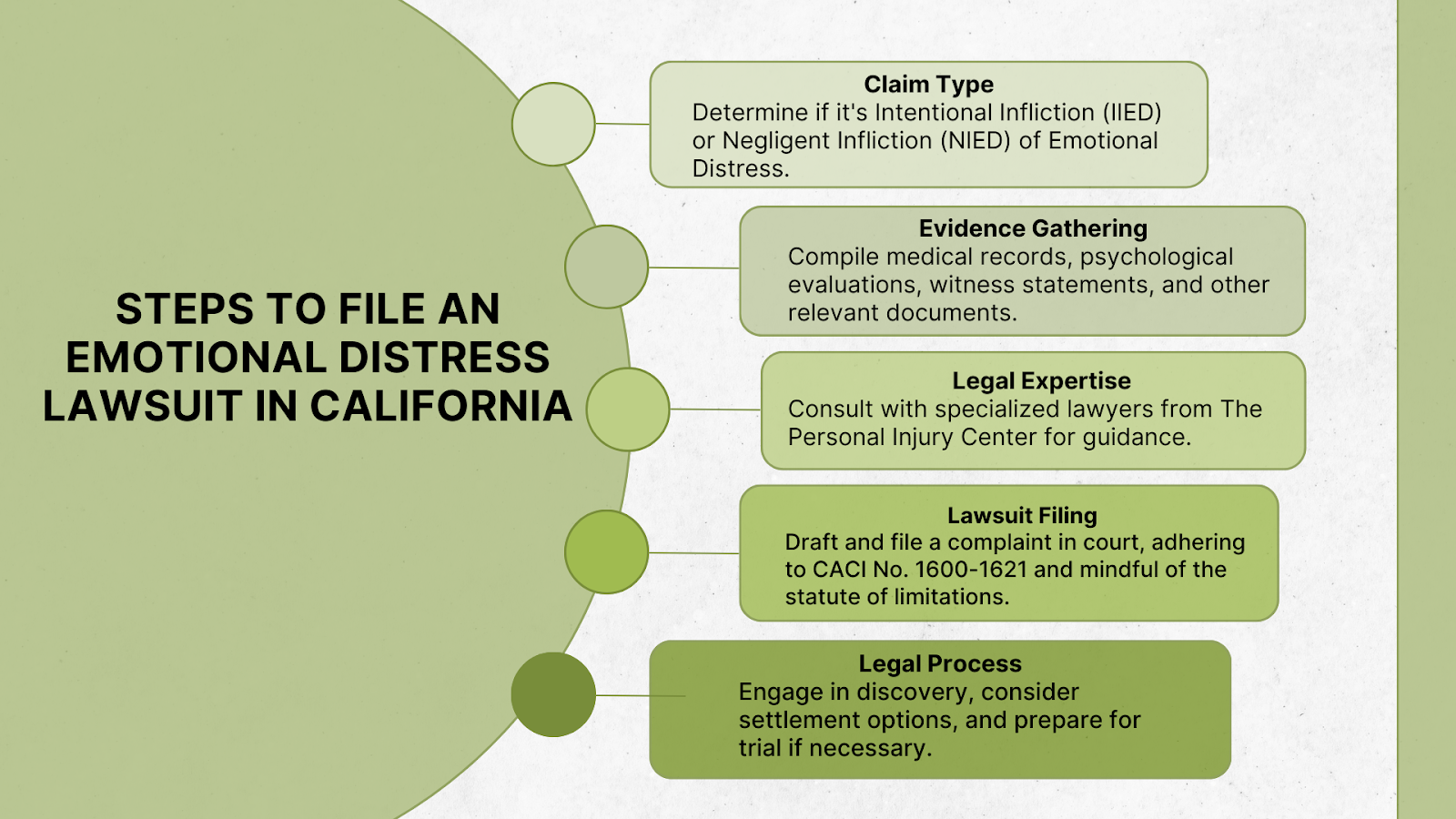In California, the evolving landscape of personal injury law increasingly recognizes the importance of emotional distress damages. These damages encompass not just the physical aftermath of an incident but also delve into the profound psychological impacts an individual may endure.
Consider the famous case of Molien v. Kaiser Foundation Hospitals. This landmark decision in California set a precedent by recognizing emotional distress as a legitimate, compensable injury.
In this article, we delve into the emotional distress damages California laws, providing essential insights for individuals coping with the often unseen but deeply impactful effects of emotional trauma.
- What Comes Under California’s Emotional Distress Damages?
- Emotional Distress Claims Under California Law
- How to File an Emotional Distress Lawsuit in California?
- How Much Compensation Can You Get for Emotional Distress Damages?
- What Factors Can Affect Compensation Amount for Emotional Distress?
- Seeking Emotional Distress Damages in California?
What Comes Under California’s Emotional Distress Damages?
The scope of emotional distress damages within personal injury law encompasses a wide range of significant psychological impacts that an individual might endure due to an incident. These impacts are often as debilitating as physical injuries.
The Judicial Council of California Civil Jury Instructions (CACI) specifically defines emotional distress as encompassing “suffering, anguish, fright, horror, nervousness, grief, anxiety, worry, shock, humiliation, and shame.” Here are various forms of emotional distress commonly recognized in personal injury cases:
- Anxiety: This includes intense, excessive, and persistent worry or fear about everyday situations, often disproportionate to the actual threat posed.
- Depression: A serious mood disorder characterized by persistent feelings of sadness and loss of interest, significantly impacting daily functioning.
- Post-Traumatic Stress Disorder (PTSD): A psychiatric condition that can develop in people who have experienced or witnessed a traumatic event. Symptoms may include flashbacks, nightmares, severe anxiety, and uncontrollable thoughts about the event.
- Loss of Enjoyment of Life: This occurs when a person is no longer able to enjoy the day-to-day activities and pleasures of life due to their emotional state.
- Humiliation or Embarrassment: Feelings of intense shame or mortification related to the circumstances or aftermath of the incident.
- Insomnia or Other Sleep Disorders: Difficulty in falling or staying asleep, often directly linked to the trauma experienced.
Emotional Distress Claims Under California Law


In California, the legal system recognizes emotional distress as a valid form of damage in personal injury cases, highlighting the state’s progressive approach to the full spectrum of harm individuals can suffer.
These can be divided into the following categories:
Intentional Infliction of Emotional Distress (IIED)
IIED occurs when an individual deliberately causes severe emotional distress to another person through extreme or outrageous conduct. This is not about mere insults or annoyances; the behavior must be so cruel or shocking that it goes beyond all bounds of decency.
For a successful Intentional Infliction of Emotional Distress (IIED) lawsuit in California, the plaintiff needs to show that the defendant’s actions were either deliberate or reckless, the behavior was extraordinarily outrageous, it directly resulted in emotional distress, and that the distress suffered was intense.
Cases of IIED often involve actions that are intended to humiliate, intimidate, or threaten, such as harassment, stalking, or abuse.
Negligent Infliction of Emotional Distress (NIED)
NIED claims address situations where a person suffers emotional distress due to someone else’s negligent actions, rather than deliberate intent. This recognizes that negligence can have serious psychological consequences.
Essential components involve demonstrating that the defendant owed a duty of care to the plaintiff, there was a failure to uphold this duty due to negligence, and this failure directly led to the emotional distress experienced.
This often involves showing that the defendant’s actions created a foreseeable risk of emotional harm. For example, in a car accident caused by negligent driving, the emotional trauma experienced by victims is a foreseeable consequence.
How to File an Emotional Distress Lawsuit in California?


Navigating the complexities of filing a lawsuit for emotional distress damages in California can be daunting, yet having a clear understanding of the essential steps and relevant state laws can greatly empower your pursuit of justice.
Determine the Type of Emotional Distress Claim
Firstly, determine if your case is Intentional Infliction of Emotional Distress (IIED) or Negligent Infliction of Emotional Distress (NIED). This classification is crucial as it influences the legal approach and potential outcomes.
Gather Evidence
Comprehensive evidence is the cornerstone of your claim. This includes:
- Medical records: Highlighting any medical or psychological treatment received.
- Psychological evaluations: Professional assessments to establish the extent of emotional distress.
- Witness statements: Accounts from individuals who can attest to the change in your mental well-being post-incident.
- Other documentation: Any relevant material that substantiates your claim, including incident reports, correspondence, or photographic evidence.
Consult with a Legal Expert
Engaging with a lawyer who specializes in emotional distress claims is a crucial step in your journey toward justice. The Personal Injury Center is here to connect you with expert attorneys in California, experts who understand the intricacies of your situation.
These legal professionals are essential in skillfully relating your emotional distress damages to the specificities of your case, ensuring that every aspect of your suffering is acknowledged and addressed.
File the Lawsuit
Filing the lawsuit is a crucial step, and this is where your attorney’s expertise becomes invaluable. They will draft and file a legal complaint in the appropriate California court, ensuring that it accurately details your claim and adheres to (CACI) No. 1600-1621. These instructions are vital as they outline the requirements for proving emotional distress in a court of law, helping to guide the framing of your case.
It’s crucial to be aware that, according to Section 335.1 of the California Code of Civil Procedure, individuals generally have a two-year period starting from the incident date to initiate a personal injury lawsuit.
However, it’s important to note that in certain cases involving emotional distress, the “discovery rule” may apply. This rule can extend the filing deadline when the emotional distress was not immediately apparent following the incident.
Proceed with the Legal Process
The discovery phase is a crucial stage in your lawsuit, governed by the California Code of Civil Procedure Sections 2016.010-2036.050. Here, you and the defendant exchange vital information, encompassing document submissions, written interrogatories, and depositions (testifying). This process enables your attorney to build a strong case by collecting evidence, identifying key witnesses, and understanding the nuances of both sides’ arguments.
Following discovery, your case may either settle through negotiations or proceed to trial. Settlement negotiations offer a private and flexible resolution, often beneficial for emotional distress claims due to their subjective nature. If negotiations don’t yield a satisfactory agreement, the case moves to trial.
At this point, the court assesses your claim. Your attorney plays a pivotal role in presenting your case, arguing the extent of your emotional distress, and advocating for appropriate compensation. This phase is your opportunity to fully articulate the impact of your emotional suffering to the judge or jury.
How Much Compensation Can You Get for Emotional Distress Damages?


In California, calculating compensation for emotional distress damages can be complex due to their subjective nature. The legal system primarily employs two methods for estimation: the ‘Multiplier Method’ and the ‘Per Diem’ approach. These methods are adapted based on the unique aspects of each case.
Multiplier Method
In this approach, actual damages such as medical expenses are multiplied by a certain number that reflects the severity of your emotional distress.
For instance, if your actual damages total $50,000 and a multiplier of 3 is used (considering the severity of your distress), you might estimate your emotional distress damages at approximately $150,000.
Per Diem Approach
This method assigns a daily rate to your emotional distress, which is then multiplied by the number of days you have been affected.
For example, if a daily rate of $200 is set and you’ve experienced distress for 365 days, the emotional distress damages could amount to around $73,000.
These methods consider the individuality and variability of each case. As a result, the settlement amounts for pain and suffering in California cover a broad range:
- Low Severity Level: Settlements generally range from $5,000 to $25,000.
- Moderate Severity Level: Settlements often fall between $25,000 and $100,000.
- High Severity Level: For more severe cases, settlements can exceed $100,000, sometimes significantly, potentially surpassing $500,000.
Each emotional distress case is unique, making the guidance of an experienced attorney crucial. If you’re dealing with emotional distress damages in California, reaching out to The Personal Injury Center can connect you with a skilled attorney. They can offer invaluable assistance in assessing your specific situation and helping you understand the potential range of compensation you may be entitled to
What Factors Can Affect Compensation Amount for Emotional Distress?


When it comes to determining compensation for emotional distress in California, the process is intricate and highly individualized. Unlike economic damages that have clear, quantifiable values, the assessment of emotional distress damages is influenced by several key factors:
- Severity and Duration of Emotional Distress: The level of intensity and the length of time you have suffered are paramount in determining compensation. Conditions such as chronic anxiety or PTSD, especially when prolonged, are likely to result in higher compensation. California courts acknowledge that more impactful emotional conditions warrant greater financial recompense.
- Impact on Daily Life: The way in which emotional distress affects your day-to-day life is another critical consideration. This includes its impact on personal relationships, your ability to work, and your overall quality of life. Greater adverse effects on these areas typically lead to a higher potential for increased compensation.
- Evidence and Documentation: Robust and compelling evidence is vital. This often encompasses medical records, psychological evaluations, and testimonies from mental health experts. California courts rely heavily on such documentation to grasp the extent and implications of your emotional distress.
- Associated Physical Injuries: If your emotional distress is accompanied by physical injuries, the likelihood of receiving higher compensation increases. The presence of physical injuries provides concrete evidence of the trauma endured, thereby reinforcing the emotional distress claim.
- Defendant’s Conduct: The nature of the defendant’s actions can significantly affect compensation. In cases where the defendant exhibited extreme negligence or malice, as often seen in IIED claims, the courts may award higher damages. This could include punitive damages, particularly in instances of misconduct.
- Legal Precedents and Jury Perceptions: Previous similar cases and how the jury views your claim can also influence the compensation. The level of empathy and understanding jurors have towards emotional distress can impact the amount awarded.
- Cap on Damages: In certain situations, such as in medical malpractice cases, California law limits the amount of non-economic damages, which can affect the total compensation available for emotional distress.
Key Takeaways
|
Seeking Emotional Distress Damages in California?
Confronting emotional distress and its legal implications can be challenging, but you’re not in this alone. The Personal Injury Center stands ready to support and guide you through the process of emotional distress claims in California.
Get in touch to be paired with a proficient personal injury lawyer experienced in handling emotional distress cases. We are committed to offering you insightful information and essential resources, enabling you to confidently navigate your legal path. Let us assist you in your quest for justice and fair compensation.



